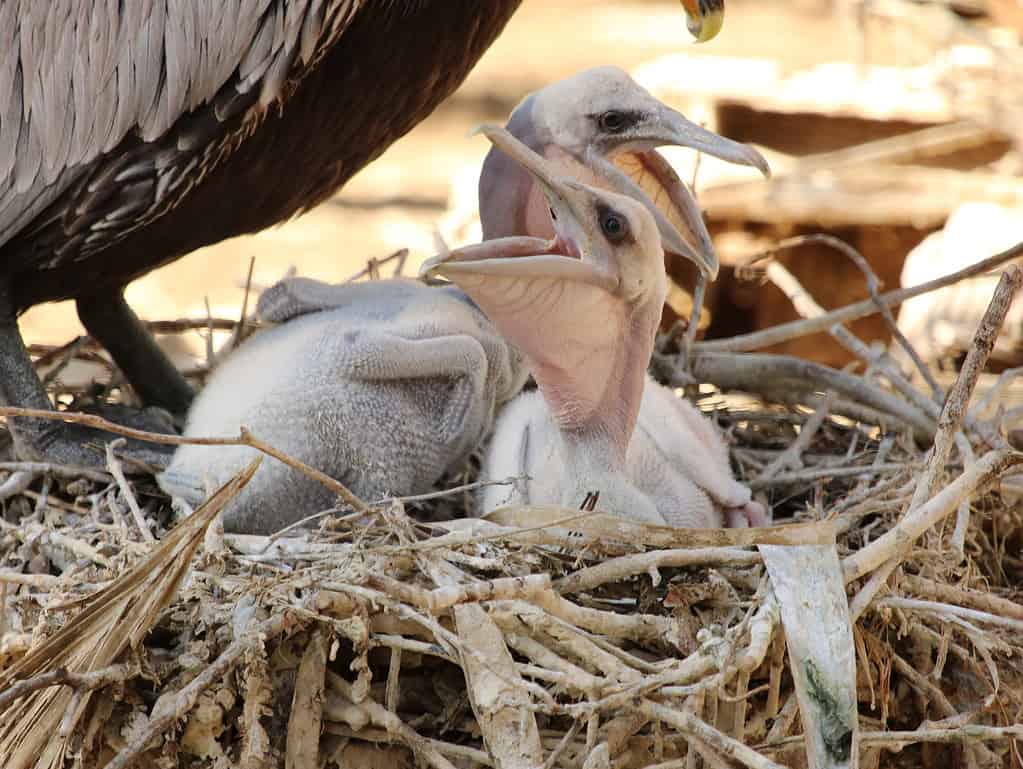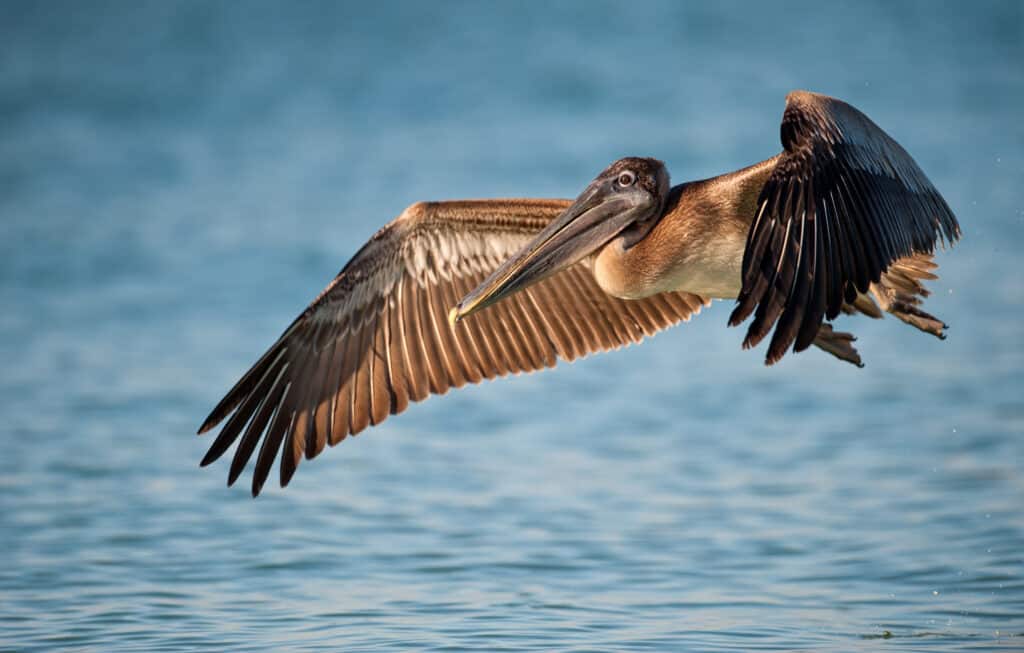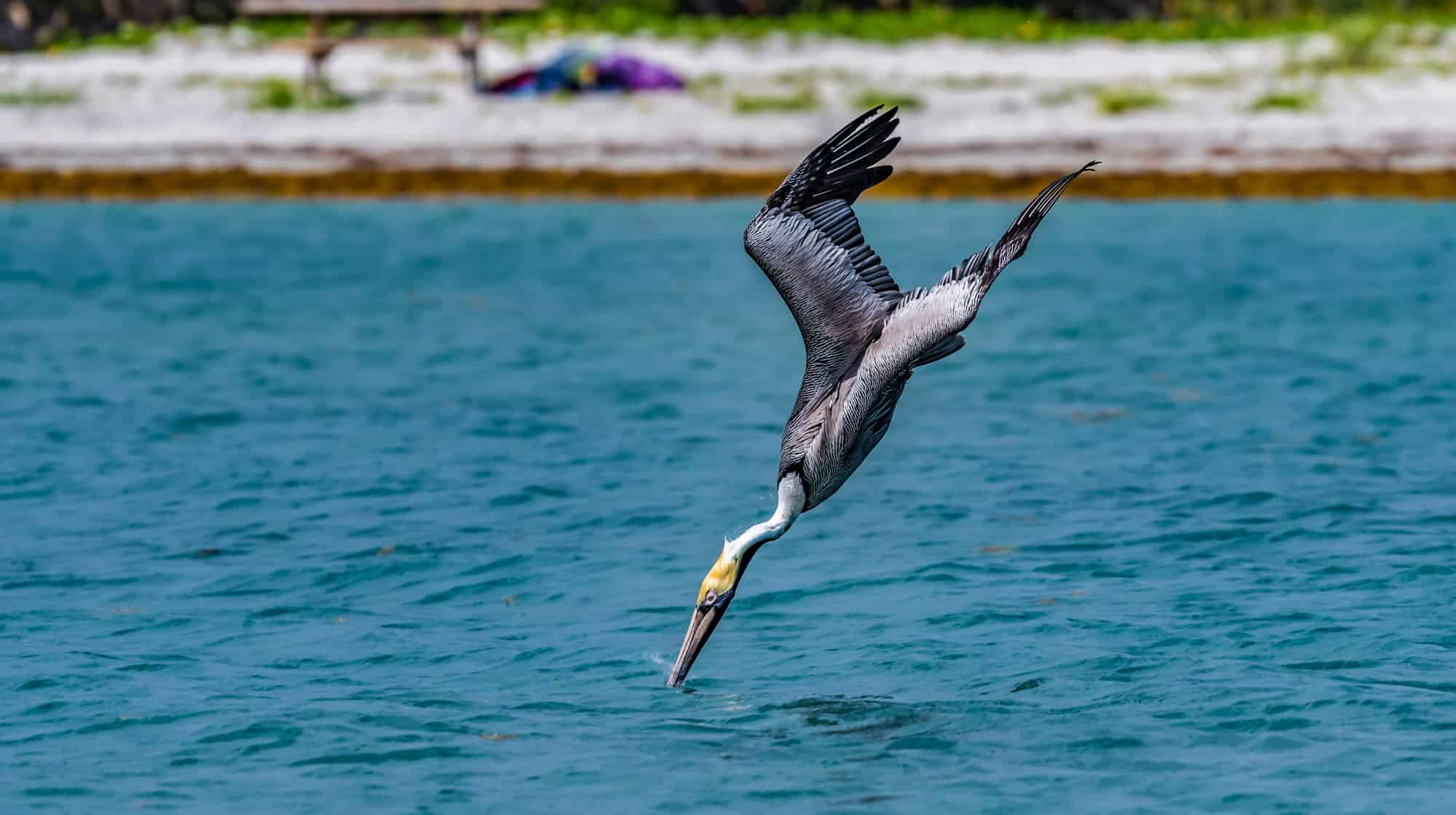The official Louisiana State Bird is the brown pelican (Pelecanus occidentalis). The legislature of Louisiana officially adopted the brown pelican on July 27, 1966. No other state has chosen the brown pelican as their official state bird. Many animals live in Louisiana, but the state has a proud connection with the pelicans that live along their vast coastlines. Louisiana, often called the Pelican State, even uses pelican symbols on their state flag and the state quarter produced by the U.S. Mint.

The state flag of Louisiana features a brown pelican feeding its young in the nest.
©iStock.com/ronniechua
Where Does the State Bird of Louisiana Live?
The subspecies of brown pelican native to Louisiana, Pelecanus occidentalis carolinensis, has a breeding range that extends along the coastline, from as far north as Maryland all the way south to Costa Rica, Panama, and possibly Venezuela. The breeding range includes the island coasts of the Caribbean. The breeding season occurs in the spring for brown pelicans living in the more northern part of their range. Individuals living closer to the tropics breed all year. During the non-breeding season, individual brown pelicans may wander inland. Birders have spotted these big birds sporadically throughout much of the eastern United States.
Where Do Brown Pelicans Nest?
The State Bird of Louisiana nests in large colonies near the shore. They typically stick to saltwater bays or island shores. Brown pelicans nest on the ground or island cliffs but sometimes in low trees. Mangroves offer usable nest sites, mainly when no preferred ground sites exist.
Brown pelicans form monogamous pairs each season but do not mate for life. The female of each pair builds the nest. Sometimes, the male helps to gather materials. Nests vary in shape and structure. Some birds make scrapes in the ground, while others pile sticks and debris to make a simple nest with an indentation. Others make large nests out of sticks in the trees.
Brown Pelican Eggs

Pelicans lay two to three large, oval, chalky white eggs per clutch.
©Alfredo Maiquez/Shutterstock.com
Brown pelicans lay two to three large, oval, chalky white eggs per clutch. Most pairs have only one clutch per year. Incubation lasts from 28 to 30 days. Both parents help incubate the eggs, using their webbed feet to help regulate their temperature. After the eggs hatch, both parents tend to their young until they fledge roughly two months later.
Brown Pelican Babies

Baby brown pelicans are blind, pink, and naked right after they hatch.
©jrubacha/iStock via Getty Images
Brown pelicans start out blind, pink, naked, and ugly. Baby brown pelicans are altricial, meaning they depend entirely on their parents for care. Both parents feed the babies with partially digested food that they regurgitate into their throats. Birth order means a lot for this species, possibly because the first chick to hatch always has an advantage at feeding time. Chicks that hatch first are almost certain to fledge, while those that hatch second may fare just a little better than a coin toss. Third hatchings in a clutch have the deck stacked against them, with only a small chance of survival.
Appearance of the State Bird of Louisiana
The State Bird of Louisiana is unique in its appearance. No other bird looks like a brown pelican, in flight or on the ground. These giant birds, roughly the size of a full-grown goose, have a huge wingspan, reaching up to 7.6 feet. Their wings naturally bow during flight. Their long bills can measure over 13 inches, and they have a large, stretchy throat pouch for catching and eating prey.
Adult Brown Pelicans

The adult brown pelican has an impressive wing span reaching 7.6 feet!
©Brian Lasenby/Shutterstock.com
Adult brown pelicans have golden, yellow crowns and white necks. The rest of their body is grayish brown. Fully grown brown pelicans can reach up to 5 feet in length, although this can be difficult to discern as they often rest with their long necks curved.
Juvenile Brown Pelicans

Juvenile brown pelicans lack the golden crown and light neck that mature birds feature.
©Nagel Photography/Shutterstock.com
Although brown pelicans hatch without feathers, they quickly grow. The juveniles have brown to grayish-brown feathers with paler plumage on the undersides. They will not have the yellow crowns or the white necks their parents sport until they reach about three years of age.
Diet

Brown pelicans can dive from great heights to catch their prey.
©mark smith nsb/Shutterstock.com
Brown pelicans eat mainly fish. They have exceptional eyesight, allowing them to see prey from above the water’s surface. When they spot a meal, they can dive from nearly 70 feet in the air and pierce the water with their long bills. The stretchy throat pouches of the brown pelican can hold up to three gallons of water, but they expel most of that by squeezing it out before they swallow their prey.
Is the State Bird of Louisiana Rare?

The State Bird of Louisiana nearly went extinct before being listed as endangered. Brown pelicans faced threats, including the fashion industry and the notorious pesticide DDT. Conservation efforts helped bring the species back from the brink, but today, it faces pollution threats, including plastics and other trash, oil spills, and other chemicals. Because it nests on low-lying islands and coastlines, it also faces the dangers of climate change, including eroding shores and magnified storms. The IUCN Red List of Threatened Species lists the brown pelican as a species of least concern. However, the species’ population has been in severe decline in Louisiana since the early 2000s. Conservationists are currently working to restore the brown pelican habitat within the Breton National Wildlife Refuge off the coast of Louisiana to help the species survive.
Thank you for reading! Have some feedback for us? Contact the AZ Animals editorial team.








